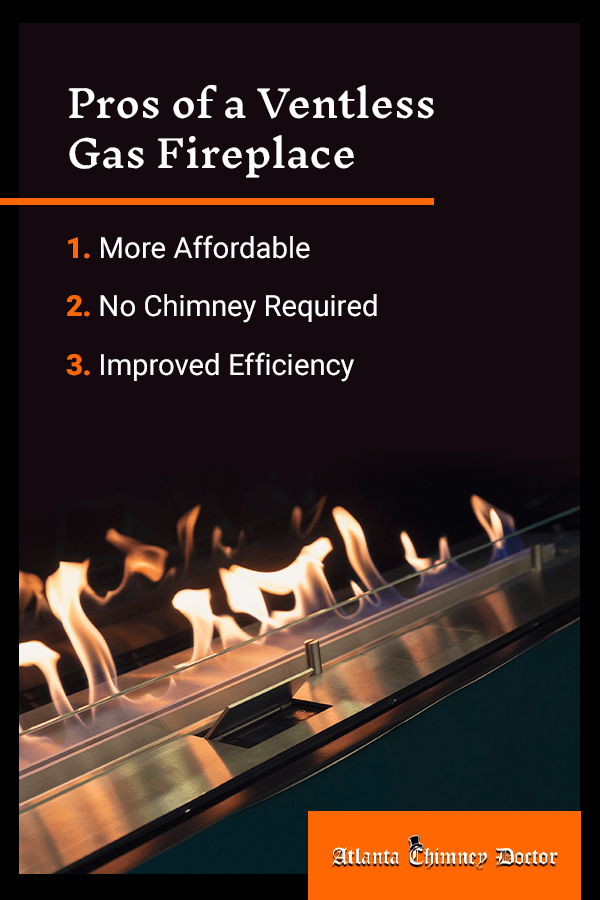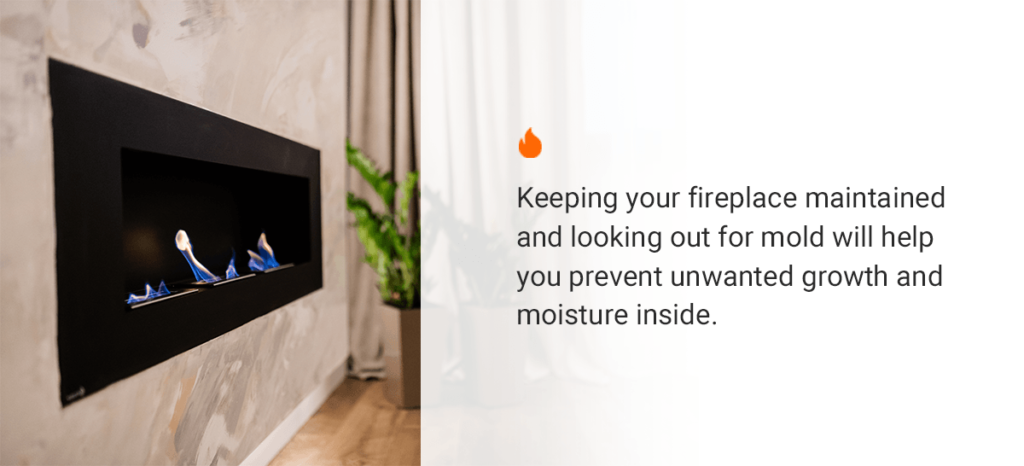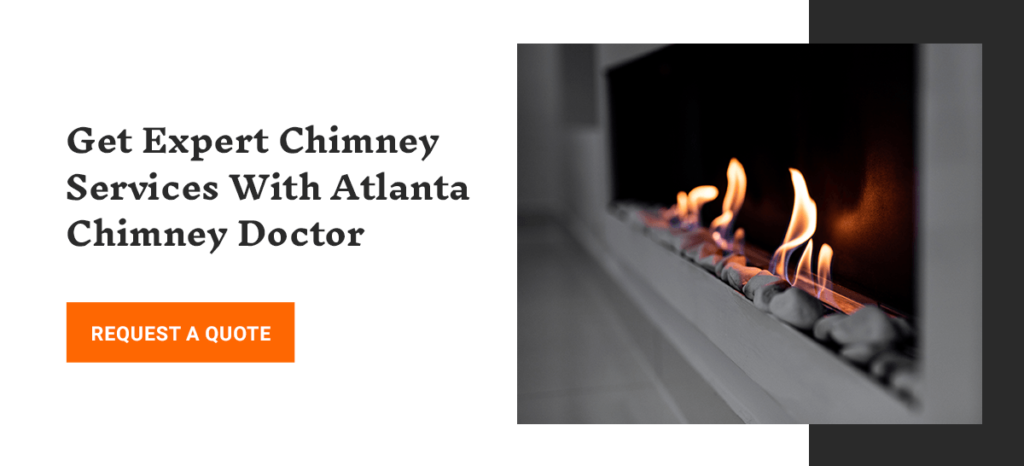A fireplace is a timeless, elegant piece for any home. While fireplaces aren’t essential for home heating anymore, they make an excellent statement feature for any room. There’s nothing like the cozy, warm atmosphere of a nice fire in the evenings to help you kick back and relax.
If you’re considering getting a vented gas fireplace, consider all your options to ensure you get a safe, efficient model for your home. Many homeowners look for ventless gas fireplaces to provide them with the warmth and sophistication of a traditional fireplace.
Let’s explore ventless gas fireplaces and what pros and cons having one will bring to your house.
What Is a Ventless Gas Fireplace?
Ventless gas fireplaces, also called vent-free gas fireplaces or unvented fireplaces, are fireplaces that don’t need a vent to carry excess fumes and gases outside the home. While traditional direct vent gas fireplaces need a chimney to release their emissions outdoors, ventless fireplaces operate more efficiently, producing fewer gases, so you don’t need a vent for the home.
These gas fireplaces use liquid propane or natural gas to run. When turned on, the gas travels through a gas burner inside the fireplace, creating heat. Ceramic fiber logs sit in the fireplace, lighting up when the gas burns and mimicking the look of a real wood-burning fireplace. Because the heat isn’t vented outside, ventless fireplaces can help make your space even warmer than a traditional fireplace.
Types of Ventless Gas Fireplaces
There are several gas fireplace ventless options you could select for your home, including:
Built-In Ventless Gas Fireplace
Built-in ventless gas fireplaces are what you want if you’re redesigning your home. They’re custom-fitted to the space, so they blend seamlessly with the rest of the room’s design. You can get a one- or two-sided fireplace built in any room. The two-sided built-in option is see-through and placed in a dividing wall, allowing you to view the fireplace from both sides.
Outdoor Ventless Fireplace
Outdoor fireplaces have stronger flames and are built from more durable materials than standard models. They have to hold up to the wind while running and resist harsh weather. If you want to add a ventless fireplace to your home’s outdoor space, make sure to choose an outdoor model specifically.
Ventless Gas Fireplace Insert
Fireplace inserts are enclosed ventless models that fit inside your existing fireplace. They’re excellent options for homeowners with fireplaces who want to avoid maintaining a vented fireplace or living with the ash and heat loss that comes with vented systems. The insert will block heat from escaping out your flue and allow you to enjoy a warm fireplace without the conditions of a vented model.
Factors to Consider When Getting a Vent-Free Gas Fireplace
Modern ventless gas fireplaces are designed to burn at almost 100% efficiency, drastically cutting the fumes released by the fireplace. However, some states still ban ventless gas fireplaces from homes despite safety regulations. You’ll need to evaluate safety and several other factors to determine if a ventless gas fireplace is suitable for your home.

Consider these factors before buying your fireplace to ensure you’re getting a model that meets your house, needs, budget and concerns:
Ventless Gas Fireplace Size
Your fireplace size will be limited based on the space it’s in. You want to ensure you select a fireplace that can produce enough heat for the room without being too hot. To do so, note the space’s square footage. With that figure in mind, you can choose a ventless fireplace model with the right British thermal unit (BTU). The BTU is the amount of heat or cooling required to raise or lower the temperature of a room.
Space
Depending on where you want to install the fireplace, you may choose one option over another. An outdoor model is ideal for your back patio, while two-sided models are perfect for dividing a space without sacrificing a fireplace view. Additionally, there are custom options for unique room setups so that you can get a fireplace that fits your room exactly.
Ventless Gas Fireplace Material
Ventless fireplaces come in different materials. Cast iron and stainless steel are two of the most popular, although other fireproof options are available. Further, artificial ceramic logs are standard for ventless fireplaces, but colored fire-safe glass and lava rocks can also be used to elevate the look of your fireplace. Play around with finishes and materials to find a fireplace that fits your home’s style.
Extra Options
Like any home appliance, there are extra options you can select to improve the convenience and experience of your fireplace. Buttons and remotes make lighting ventless fireplaces easier, while automatic ignition means you don’t need a pilot light. Many ventless models also come with options for adjusting gas usage and flame size.
Ventless Gas Fireplace Safety Features
Additional safety features can help make your home more comfortable and safe when using a ventless fireplace. Because ventless gas models use air from the room to run, many fireplaces will automatically shut off if they sense that the room’s oxygen is too low. Built-in carbon monoxide detectors will alert you if the carbon monoxide levels get too high, protecting you and your family from inhaling dangerous fumes.
Pros of a Ventless Gas Fireplace

Ventless models are ideal for homeowners who want the warmth and elegance of a fireplace without the upkeep. If you’re looking for a new fireplace, consider a ventless model for your home. They work well in different spaces and provide you with comfortable heating year-round.
Let’s look at some of the benefits of owning a ventless gas fireplace.
1. More Affordable
Ventless models are convenient to install and highly affordable, especially when compared to vented gas fireplaces. Even custom ventless fireplaces are more affordable than vented models, as they’re simple to install and don’t require the same maintenance. You can get a stylish ventless fireplace for a lower cost and still enjoy all the benefits of a fireplace’s warmth and design.
Additionally, fuel is less expensive for vented gas fireplaces compared to gas or wood-vented models. Gas is cheaper to buy and burn than wood, and it’s a much more reliable fuel source, as you don’t have to chop it yourself or wait for wood deliveries. Further, the enhanced efficiency of gas ventless fireplaces means they use less gas to produce the same amount of heat as vented fireplaces because heat isn’t wasted traveling out of the flue.
2. No Chimney Required
Because ventless fireplaces are hyper-efficient and produce few fumes, you don’t need to pay for ventilation installation. Many homes come without chimneys, and installing a flue for a fireplace is an expensive, often impractical undertaking for many homeowners.
If your home has a chimney, you’ll need to keep it in top shape to ensure everything works properly and lasts. Ventless fireplaces take that extra work out of the equation.
3. Improved Efficiency
With almost 100% efficiency, ventless fireplaces produce fewer fumes and require less fuel than vented models to produce heat. They also don’t need wood, so you won’t have to use money and space for wood storage and collecting. Their high efficiency makes them great for homes looking to invest in cost-effective, energy-efficient heating for their home.
Cons of a Ventless Gas Fireplace
While there are many benefits to ventless fireplaces, you’ll also want to consider a few downsides. You should weigh all the pros and cons of ventless gas fireplaces before making your decision to ensure you get the best fit for your home. The good news is you can manage all of these potential disadvantages to get the best use out of your ventless fireplace.
1. Potential Safety Risks
Many homeowners are concerned about the safety risks of fireplaces, whether they’re ventless or vented. So, are ventless gas fireplaces safe? The answer depends on your health concerns and the safety features of your fireplace, but for most people, ventless fireplaces are safe. There have been no documented deaths caused by ventless fireplaces with oxygen-detection sensors.
All fireplaces pose some potential safety risks. Fumes released by the fireplace may irritate some homeowners, and safety sensors can become clogged, leading to issues with the fireplace. However, following maintenance, setup and safety requirements drastically reduce any potential dangers around your fireplace.
To help protect your home and family, here are some safety tips:
- Regularly dust your fireplace sensor to clear away any dust, dirt and particles.
- Get your fireplace inspected yearly to ensure there are no leaks, clogs or other hazards.
- Place logs according to manufacturer instructions to prevent black soot and carbon monoxide buildup.
2. Increased Humidity
Because ventless fireplaces draw in air from the room and emit heat and vapor back into your home, you’ll see a humidity increase inside. This excess humidity is unavoidable but mostly minor.
Too much humidity can lead to mold growth and mildew inside, but fireplaces don’t increase humidity levels enough to cause significant issues. Keeping your fireplace maintained and looking out for mold will help you prevent unwanted growth and moisture inside.

3. Carbon Monoxide Emissions
No matter how efficient your ventless fireplace is, it’ll still emit tiny amounts of carbon monoxide. These carbon monoxide emissions are less likely to be a problem for healthy people, but they can pose significant health issues for individuals with weakened immune systems. This includes:
- People who are pregnant
- Small pets
- Older adults
- Children
- People with compromised immune systems
- People with severe allergies or asthma
- People with preexisting health conditions
- People with cardiovascular issues
While carbon monoxide fumes do pose a potential health risk for individuals with health concerns, they’re considered safe for healthy individuals to be around. Carbon monoxide sensors in your fireplace will alert you if the levels become unsafe, allowing you to leave your home quickly and get help.
4. Restricted Use
Due to the potential health risks, several municipalities and California have complete bans on ventless fireplaces. Other entities restrict the rooms and room sizes you can install these fireplaces in.
If you live in an area with bans or restrictions on ventless gas fireplaces, you won’t be able to install one in your home. You might have to install a vented fireplace instead.
How Long Can You Leave on a Ventless Gas Fireplace?
You should only use your ventless gas fireplace for six hours a day or less. If your manufacturer’s instructions have a different time listed, follow that. The manufacturer has performed all the necessary testing and knows how long you can safely leave your fireplace on each day. Following this note reduces humidity buildup and helps keep your fireplace in good condition.
If you need help remembering how long you left your fireplace on, you can get a fireplace with a timer or install your own on the gas line. These devices will let you know when you need to turn the fireplace off and help you protect your home.
Ventless vs. Vented Gas Fireplace: Which Is Better?
The right fireplace for your home will depend on your preferences, your home and local requirements. Direct vent gas fireplaces require a more significant investment if you don’t already have a chimney, and these models are less efficient than ventless fireplaces. However, they don’t have the same humidity and safety risks as ventless models.
If you’re concerned with efficiency and affordability, a ventless fireplace is probably the best option for you. If you have an existing chimney or want the look and function of a traditional fireplace, then a vented model will fit your home. Both types of fireplaces require regular maintenance, so talk to your fireplace professional about the right option for your budget, needs and lifestyle.
Get Expert Chimney Services With Atlanta Chimney Doctor
Trust Atlanta Chimney Doctor with your next chimney job. With over 30 years of fireplace and chimney experience, we deliver fast, safe and efficient chimney services to Atlanta residents. If you have a chimney in need of inspection, repair or remodeling, you can count on our team to bring your flue up to code. Keep your home and your family safe with high-quality, lasting chimney and fireplace services.
Looking for safe, fully-insured chimney services? Contact us and request a quote today!

